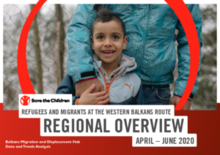Data and Trend Analysis (DATA) Refugees and Migrants at the Western Balkans Route Regional Overview, covering period April – June 2020, describes key trends in migrations in the region, detailing information about the number of people on the move, demography (age, sex, country of origin, etc), behavioral patterns, and routes in use - with a focus on children, particularly unaccompanied children.
Key trends showcased in this report:
- More than 140,000 refugees and migrants are currently staying in the Balkans (138,500 estimated in the first quarter of 2020)
- Families traveled somewhat less during the pandemics and, as in previous periods, they mostly came from Syria and Iraq. The available data shows that the proportion of children in the total migrant population was lower than in the previous period.
- Most of UASC in all the Balkans countries were traditionally boys from Afghanistan and Pakistan, with children from African countries as well as Syria emerging as unaccompanied travelers as well.
- Movements between Balkan countries were very dynamic regardless of COVID-19. Macedonia alone received more than 7,000 new refugees and migrants, mostly from Greece.
- Existing transit corridors: Bulgaria/North Macedonia/Serbia, Kosovo*/ Serbia, as well as Albania/Montenegro, usually merged in Bosnia and Herzegovina (BiH). Although the number of refugees and migrants trying to cross the Hungarian or Romanian border remained relatively high, with smaller movement from Bulgaria to Romania, BiH still remains the most used exit route.
- The route through Kosovo*, which was dominant in the last 6 months, was almost abandoned during the second quarter of 2020.

